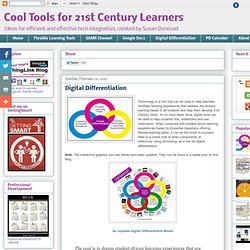

Diigo Tutorial. MentorMob - Learn What You Want, Teach What You Love. Using an iPad as a Document Camera. Comparing 12 Free Screencasting Tools. Combing through the basic functions and features of a list of tools I’ve become aware of, to select some for further testing.

Over the course of the week, the list of Screencasting tools that have been recommended to me, or that I’ve otherwise learned of, has grown to a dozen. I have a goal of trying identify a free tool or set of tools to use to create stand alone tutorials by combining screen images and screen motion with audio. I would also like to have some editing capabilities, so I could combine multiple captures and rearrange the order of these pieces if needed, and to be able to re-record audio annotation if possible.
I would also like to have screen annotation capabilities, at least for the screen captures. Given this set of desired functions and features, and the long list of tools, it’s only logical that I briefly review each application to see what they can do. Feature/Function Summary Table About Kelly Walsh Print This Post. Organize your resources in an online binder - LiveBinders. Digital Differentiation. Technology is a tool that can be used to help teachers facilitate learning experiences that address the diverse learning needs of all students and help them develop 21st Century Skills.

At it's most basic level, digital tools can be used to help students find, understand and use information. When combined with student-driven learning experiences fueled by Essential Questions offering flexible learning paths, it can be the ticket to success. Here is a closer look at three components of effectively using technology as a tool for digital differentiation. Note: The interactive graphics you see below have been updated. They can be found in a newer post on this blog. The goal is to design student-driven learning experiences that are fueled by standards-based Essential Questions and facilitated by digital tools to provide students with flexible learning paths. Essential Questions: Student-driven learning experiences should be driven by standards-based Essential Questions. The 35 Best Web 2.0 Classroom Tools Chosen By You.
100 Web 2.0 Tools Every Teacher Should Know About 44.24K Views 0 Likes We're always trying to figure out the best tools for teachers, trends in the education technology industry, and generally doing our darnedest to bring you new and exciting ways to enhance the classroom. But I wanted t... 20 Free and Fun Ways To Curate Web Content 23.98K Views 0 Likes What's the best way to organize it all into at least some reasonable manner? It’s Time To Crowdsource Your School’s Social Media Policy 12.53K Views 0 Likes Every school has a different policy when it comes to social media. 30 Webtools to Transform a Classroom. Kathy Schrock's Guide to Everything. Teachweb2 - home. Technology and Teaching Writing. Is it a given that technology enhances the acts of writing, as it does the arts and sciences of film-making, design, engineering, data collection and analyses, and so forth?

What about the teaching and learning of writing? In a flurry of recent exchanges (subject “Writing horse-shoe-of-horse-heading-east Technology”) on the Writing Program Administration (WPA) listserv, scholars in writing studies have argued these points in some theoretical and practical depth. Maja Wilson, from the University of Maine, sums up the argument nicely: "Steve [Krause, of Eastern Michigan University], and others were arguing that to teach writing, you need to teach the tools available now and not teach or allow the tools on their way out (pen, pencil), because if you aren't teaching the tools, you aren't teaching writing.
I was recently named Southern Connecticut State University, New Haven’s 2011 Outstanding Technological Teacher. The Ups. Engaging Students with Engaging Tools (EDUCAUSE Quarterly. Key Takeaways A new course teaching media, mass communication, and political identities in the Middle East and North Africa explored the use of social media in pursuit of effective learning. Using a variety of social media and other tools encouraged student engagement in and out of the classroom. Student responses varied from discomfort with the technology to enthusiastic adoption and continued use after the course ended. This article records my experiences teaching a new course in early 2009 at Dickinson College, a four-year liberal arts college in Pennsylvania serving around 2,300 undergraduates.
The course emphasized newer and emerging media and technologies such as satellite television, the Internet, and mobile telephony. In a class of 21, there was naturally a range of responses to the different technologies used, from enthusiastic embrace through indifference to active resistance. Learning Through Digital Media. Blogs Wikis Docs Chart.
Tech Tutorials. Creativity Tools. eBooks. Collaboration. Social media.